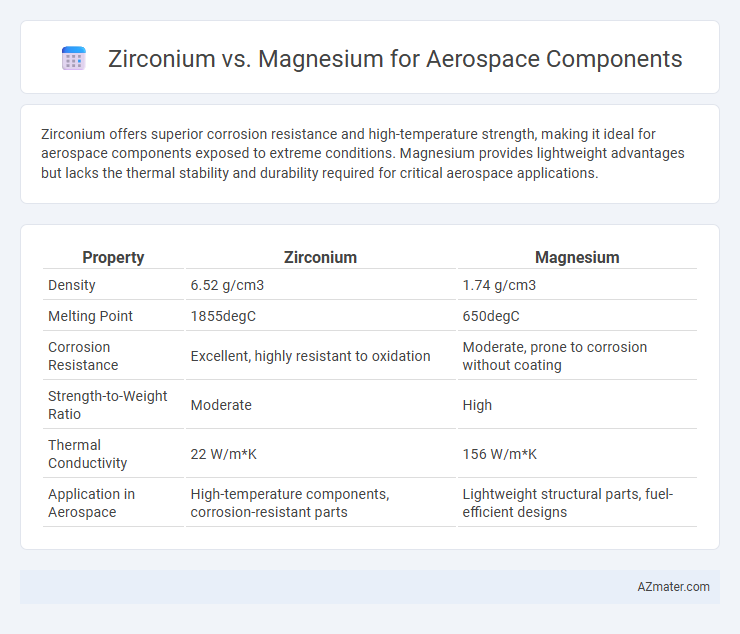Zirconium offers superior corrosion resistance and high-temperature strength, making it ideal for aerospace components exposed to extreme conditions. Magnesium provides lightweight advantages but lacks the thermal stability and durability required for critical aerospace applications.
Table of Comparison
| Property | Zirconium | Magnesium |
|---|---|---|
| Density | 6.52 g/cm3 | 1.74 g/cm3 |
| Melting Point | 1855degC | 650degC |
| Corrosion Resistance | Excellent, highly resistant to oxidation | Moderate, prone to corrosion without coating |
| Strength-to-Weight Ratio | Moderate | High |
| Thermal Conductivity | 22 W/m*K | 156 W/m*K |
| Application in Aerospace | High-temperature components, corrosion-resistant parts | Lightweight structural parts, fuel-efficient designs |
Introduction to Zirconium and Magnesium in Aerospace
Zirconium and magnesium are critical materials in aerospace engineering due to their unique properties. Zirconium offers excellent corrosion resistance and high strength-to-weight ratio, making it suitable for aircraft engine components and structural parts exposed to extreme conditions. Magnesium is prized for its ultra-lightweight characteristics and good mechanical performance, commonly used in aerospace alloys to reduce overall weight and improve fuel efficiency.
Material Properties: Zirconium vs Magnesium
Zirconium offers superior corrosion resistance and high-temperature stability compared to magnesium, making it ideal for aerospace components exposed to extreme environments. Magnesium provides excellent lightweight characteristics with a density roughly one-third that of zirconium, but it has lower tensile strength and reduced fatigue resistance. The choice between zirconium and magnesium hinges on balancing zirconium's durability and magnesium's weight-saving benefits in aerospace applications.
Weight Considerations for Aerospace Components
Zirconium offers higher density at approximately 6.52 g/cm3 compared to magnesium's lightweight density of about 1.74 g/cm3, making magnesium preferable for aerospace components where weight reduction is critical. Magnesium's superior strength-to-weight ratio enhances fuel efficiency and payload capacity in aerospace applications. Despite zirconium's excellent corrosion resistance and strength, magnesium's significantly lower mass provides substantial benefits in minimizing overall aircraft weight.
Strength and Durability Comparison
Zirconium exhibits superior strength and corrosion resistance compared to magnesium, making it ideal for aerospace components exposed to high stress and harsh environments. Magnesium offers a lightweight advantage but has lower tensile strength and durability, limiting its use to less critical parts or applications requiring weight reduction over structural integrity. Zirconium's combination of high strength-to-weight ratio and exceptional fatigue resistance enhances the longevity and safety of aerospace structures.
Corrosion Resistance: Zirconium vs Magnesium
Zirconium exhibits superior corrosion resistance compared to magnesium, making it ideal for aerospace components exposed to harsh environmental conditions and oxidative stress. Magnesium, while lightweight, is highly susceptible to corrosion, especially in saltwater or humid environments, necessitating protective coatings for aerospace applications. The enhanced corrosion resistance of zirconium alloys extends the lifespan and reliability of critical aerospace parts, reducing maintenance costs and improving safety.
Thermal Stability and Conductivity
Zirconium offers superior thermal stability with a melting point of approximately 1855degC, making it ideal for aerospace components exposed to extreme temperatures. Magnesium, while having excellent thermal conductivity around 156 W/m*K, has lower thermal stability due to its melting point near 650degC, limiting its use in high-heat environments. The combination of zirconium's high-temperature resistance and moderate conductivity supports aerospace applications requiring durability and thermal management under severe conditions.
Machinability and Fabrication Techniques
Zirconium offers superior corrosion resistance and high strength at elevated temperatures, making it suitable for aerospace components requiring durability in extreme environments, but its machinability is challenging due to its hardness and tendency to gall. Magnesium, known for its low density and excellent machinability, allows for faster fabrication and reduced weight, enhancing fuel efficiency in aerospace applications. Advanced fabrication techniques such as precision CNC machining, electrical discharge machining (EDM), and heat treatment optimize component performance for both metals, with Zirconium often requiring specialized tooling and coolant use to manage heat and tool wear.
Cost Analysis in Aerospace Applications
Zirconium offers superior corrosion resistance and high-temperature stability compared to magnesium, but at a significantly higher cost, influencing aerospace manufacturers to weigh performance benefits against budget constraints. Magnesium's lightweight properties make it attractive for weight-sensitive aerospace components, yet its lower price is offset by corrosion and strength limitations that can increase lifecycle costs. Cost analysis in aerospace applications must balance initial material expenses, maintenance, and durability, often favoring zirconium for critical high-stress parts despite magnesium's cost advantage in non-critical, weight-driven components.
Environmental Impact and Sustainability
Zirconium's corrosion resistance and durability contribute to longer aerospace component lifespans, reducing material waste and lowering environmental impact through decreased replacement frequency. Magnesium's lightweight nature significantly enhances fuel efficiency, resulting in reduced carbon emissions during aircraft operation, although its recyclability is more limited compared to zirconium. Sustainable aerospace design increasingly favors zirconium alloys for end-of-life recyclability, while magnesium's role is optimized through lightweighting strategies to minimize overall environmental footprint.
Choosing the Right Material for Aerospace Components
Zirconium offers exceptional corrosion resistance and high strength-to-weight ratio, making it ideal for aerospace components exposed to extreme environments. Magnesium provides superior lightweight properties and good machinability, suitable for applications where weight reduction is critical. Selecting the right material depends on balancing strength, corrosion resistance, and weight requirements specific to aerospace operational conditions.

Infographic: Zirconium vs Magnesium for Aerospace Component
 azmater.com
azmater.com